| Sep-09-04 | | Elrathia Kingi: Nxf6 and white gets a queen. |
|
| Sep-10-04 | | azaris: 52. ♘xf6!! gxf6
(52...♗f7 53. ♘h7 ♔d6 54. ♘xg5  ) )
53. f4
(53. h6? ♗g8 54. e5 fxe5 55. ♔e4 ♔d6 56. ♔f5 ♗h7+ 57. ♔f6 ♔d5 58. ♔xg5 ♔e6 59. ♔h4 =) 53...gxf4+ 54. ♔xf4 ♔d6 55. h6 ♗g8 56. ♔f5 ♔e7 57. ♔g6 (57. g5? fxg5 58. ♔xg5 ♔f7 59. e5 ♗h7 =)
57...♔f8 58. h7 ♗xh7 59. ♔xh7 ♔f7 60. e5! fxe5 61. g5 e4 62. g6+  |
|
Aug-06-23
 | | KEG: An extremely frustrating game to play over. If the score in the Tournament Book is to be believed--and in at least one case it plainly should not--this game was replete with bad mistakes and missed chances. The game score ends with the 51st move of Eisenberg. All we know from there is that Gunsberg ultimately prevailed. After Eisenberg's 51st move, Gunsberg had a clear win in what appears to be a childishly simple minor piece endgame. But the line suggested in the Tournament Book from the final recorded position is poor and could well botch the easy win. And the continuation given on this site completely throws away the win, and would lead to a win for BLACK if followed up as suggested. A strange state of affairs.
1. e4 e5
2. Nf3 Nc6
3. Bc3 Bc5
The Ruy Lopez had become the Open Game of choice for White by 1902, so it is refreshing to see Gunsberg try something else. But, as will be seen, Gunsberg thoroughly misplayed the opening and was fortunate not to have been crushed at the outset. 4. d3
A solid line...unless followed up as Gunsberg did in this game. 4... d6
5. Ng5

click for larger viewSeems disjointed, but...believe it or not...Stockfish played it twice against Alpha Zero (drawing both games, one in 130 moves and the other in 255 moves!). The move therefore cannot be called any sort of objective "mistake." 5... Nh6
The only plausible alternative is 5...Qf6 (threatening mate in one!). Alpha Zero tried both it its two game against Stockfish in this opening, drawing on both occasions. After 5...Nh6, the position was:

click for larger view6. Qh5?!

click for larger viewHuh? Who turned off the lights? I might have had even harsher words for this move had not it been repeated in Tartakower--Spielmann, Bad Pistyan 1922. So far as I am aware, this two games are the only times 6. Qh5 was played here. It's not as if White had been strapped for a good 6th move here. 6... Qf6
This is sufficient to give Black the better game, and it was Spielmann's choice in 1922 in his game which he went on to win. There is, however, a stronger move for Black, but one I would not venture over the board: 6...Bg4! Things could then get wild: 7. Bxf7+ (7. Qh4 is a less violent alternative that leads to a small edge for Black) Kd7 8. Qh4 (forced) Rf8 (forced) 9. f3 RxB 10. Qg3 (forced) Rf6 11. Nxh7 Be6 12. NxR+ QxN leaving Black with two minor pieces for Rook and two pawns and the superior game. 7. f3?
Amazingly, Tartakower also played this lemon which yields close to a winning game for Black (on move 7!). 7. Nf3, though conceding that White's opening was a mistake, was much better, as were 7. 0-0 or even 7. Be3. White has to anticipate 7...Nd4. 7... Nd4
Of course!
What a horrific position for White after just seven moves: 
click for larger viewWhite is probably not theoretically lost here, but to this point the game looks like something I might have played as White at about age 6, and could serve as a lesson for the need for White to develop his/her pieces before playing moves such as Ng5 and Qh5. |
|
Aug-07-23
 | | KEG: Post II
8. Bb3
The alternative, 8. Kd1, was also not very savory for White. 8... c6?
Here Rudolph Spielmann played the far better 8...Qg6, traded Queens, chased away the White Knight with 10...f6, and went on to win. Eisenberg Queen-side expansion idea was weak---until Gunsberg came to his rescue on his next move. After 8...c6?, the position was:
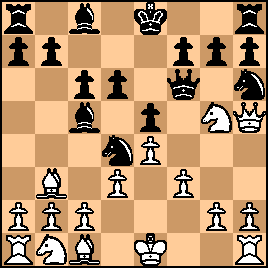
click for larger view9. Nc3?
Exactly the wrong time for this over-due development of the b1 Knight. With Black bearing down on him, and after Eisenberg's weak 8th move, Gunsberg could have gone a long way towards righting his ship with 9. c3! But with the text, Gunsberg gave Eisenberg another chance to take charge. 9... b5?
With 9...a5, and perhaps also with 9...Qg6 followed by f6 and a5, Eisenberg could have truly made Gunsberg sweat. Now White could--and did--escape the worst: 10. Ne2!
All of a sudden, White can take a breath again.
10... NxB
11. axN

click for larger viewGunsberg's only real problems now were his misplaced Queen and g5 Knight. Happily for him, Eisenberg again came to the rescue: 11... Qg6
Manna from heaven for White He would still have had problems to confront after 11...a5 (or 11...Bb6 followed by 12...a5). But now: 12. QxQ hxQ
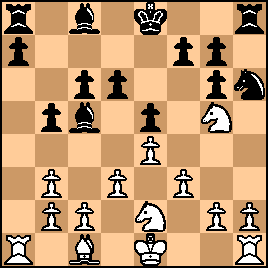
click for larger viewNow, with 13. f3 (allowing the retreat of his Knight to f3), White would have a fair--if slightly inferior--game. But, Gunsberg was still hell-bent on some kind of King-side attack. So: 13. h4?! f6
Now the White Knight has to retreat to the inferior h3 square. Alternatively, Eisenberg could have tried the more aggressive 13...a5. 14. Nh3
A sorry landing spot for the adventurous White Knight, but--thanks to Eisenberg's questionable play, White's position is now not so awful. 14... Nf7
14...a5 was still a possibility, but the text is also understandable. 15. Nf2

click for larger viewHaving completed his grand retreat, Gunsberg could still live to fight after a bit. 15... Bb6
Somewhat lame, but even with the more enterprising 15...Bd7 or 15...b4, Black's chances for a quick knock-out were gone. 16. Bd2
Gunsberg still seemed to be a tad asleep at the switch. 16. Nd1 was the better way to regroup. 16... Be6
Now, surely, Eisenberg should have tried 16...a5. Now, yet again, Gunsberg could have solidified his position, the board now showing: 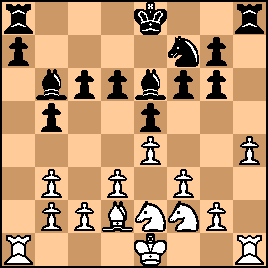
click for larger viewA quick side-bar. In my last post, I failed to mention the seemingly obvious mistake in the Tournament Book score. It gave 8. Nc3--which loses instantly to a Knight fork. This site gives 8. b3 as the actual move, and that move---and not what was in the Tournament Book--is undoubtedly what was actually played by Gunsberg.. |
|
Aug-07-23
 | | KEG: Post III
Play continued in a fog. Gunsberg going into this game was +1 and still had hopes (later dashed) of at least a minor prize. He was a threat at his best to the top players, and indeed defeated tournament-leader Maroczy in the next round, almost costing him first place. Eisenberg was tied for 17th-18th place (out of 20) at the start of this game, and Gunsberg perhaps wanted to keep the game going until Eisenberg handed him the point. If this was the strategy, it ultimately worked in this case. But Gunsberg had to take care, Eisenberg could at times be dangerous, and had already taken down the mighty Pillsbury when the latter pushed too hard. 17. Ng3
A poor plan (preparing for h5). Gunsberg could have equalized with the simple 17. Ba5. But perhaps he was itching for more than a draw. 17... Bd4
Hard to see the point in this, unless he guessed that Gunsberg would not try to defend the b2-pawn and instead overstretch. 17...a5 looks indicated. 18. h5?!
White looks safe with 18. Bd1 (or perhaps 18. Bc3), but Gunsberg still wanted to mix it up. Drawing with Eisenberg was not the way to try to nab a prize. The text left:
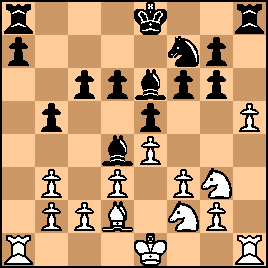
click for larger view18... g5?!
Perhaps reasoning that what Gunsberg wanted couldn't be good for Black. But here Eisenberg gets the edge with 18...gxh5. Needless to say, he disdained grabbed the White b2 pawn (which in fact is inferior to 18...gxh5). 19. c3
Once again, Gunsberg was fine--but held no advantage and seemed nowhere near getting the win he wanted. 19... Bb6
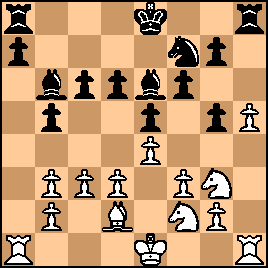
click for larger view20. Ke2?
Showing no interest in the equalizing 20. Nf5 (e.g., 20...BxN 21. exB a5 22. Ke2). But wait a minute, isn't a White pawn hanging now? 20... a5?
Why not just grab the pawn with 20...Bxb3?
Now again Nf5 beckons for White. But Gunsberg had other (strange) ideas: 21. b4?! a4

click for larger viewYet again, Gunsberg could simply have played Nf5. 22. Be3 was also OK here. But Gunsberg seemingly remained convinced that Eisenberg would self-destruct if only the game remained complicated and was extended. So: 22. Nf1?
Now Black can seize the initiative with 22...d5, a move most of us would make almost reflexively. But Eisenberg decided it was more important to connect his Rooks and remain poised to play on both wings. So: 22... Kd7?!
23. Be3 Kc7
24. BxB+
24. g4 was also a possibility.
24... KxB
25. Ne3

click for larger viewThus far, Eisenberg--despite his often nebulous play--hadn't cracked or handed the game to Gunsberg. All that was about to change as the move-30 time control grew closer. |
|
Aug-08-23
 | | KEG: Post IV
25... c5?
Missing what turned out to be his final opportunity to take the initiative and hold any advantage. 25...d5 was plainly best. 26. g4!
With the clocks running down to the move-30 time control, Gunsberg finally showed his mettle. Having locked up the King's side and with Black having few trumps on the other wing, White was now seemingly safe. 26... cxb4
Giving Gunsberg an isolated doubled b-pawn, but with the pawn configuration being what it was, this conferred no significant plus for Black. 27. cxb4 Rhc8
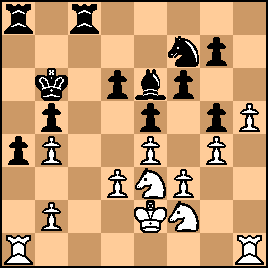
click for larger viewOne might at this stage have imagined that the game would drift off towards a draw. But that's not at all what happened. 28. Nfd1
A sort of nothing move waiting for Eisenberg to collapse. If my hunch is correct, Gunsberg didn't have long to wait. 28... Kb7?
Huh? Why leave the b5 pawn undefended? 28...Nd8 (with a view to 29...Nc6) seems indicated. Alternatively, if Eisenberg wanted to play a waiting game, he could have tried 28...Ka6. 29. Nc3!
Of course. Now Black--for the first time in this game--faced danger: 
click for larger view29... a3?!
Doing nothing to address his weaknesses. Like it or not, Black had to try 72...Bd7 or 72...Ka6 or 72...Kb6 or 72...Kc6. 30. Kd2!
Beautifully times by Gunsberg.

click for larger view30... axb2
Pretty much forced.
31. RxR RxR

click for larger view32. Rb1 Bd7
33. Rxb2

click for larger view33... Nd8
Digging a deeper hole for himself. 33...Ra1 was best. 34. Ra1

click for larger viewThis may already be lost for Black. In any case, after Eisenberg'g blunder on his next move, the end was in sight. |
|
Aug-08-23
 | | KEG: Post V
34... Ne6?
Facilitating his own demise. 35. Nf5 had to be anticipated. The text blocks his own Bishop. After this, the game--from any objective perspective--was lost for Black. 35. Nf5!
Predictable...and crushing.
35... Nd4
Best, but insufficient.
36. NxN exN
37. Ne2
Ouch.
Now Black loses a pawn...and the game:
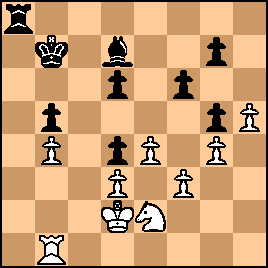
click for larger view37... Ra2+
38. Kd1 Ra3
39. Kc2

click for larger view39... d5
Desperation. But I see nothing significantly better for Black. 40. Nxd4 dxe4
40...Kc7 is also hopeless.
41. dxe4
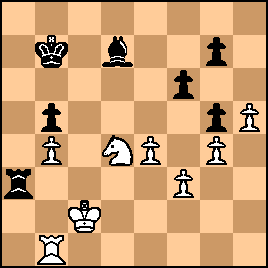
click for larger view41... Ra2?
This should have eased Gunsberg's task since 42. Kb3 would now be crushing. But the approach of the move-45 time control may have played a factor. 42. Kd3?

click for larger viewGiving Eisenberg a ghost of a chance. But instead of the last-chance 42...Ra3+. Eisenberg played: 42... Kc7?
Now the ending should have been easy for White, even with the clock running. 43. Rc1+ Kd6
44. Rc5!
Black is busted. But move-45 had not yet been reached. 44... Ra3+

click for larger view45. Ke2
45. Kd2 was simpler, but the text still left White in control. 45... Ra2+
46. Ke3 Rb2
Planning a final desperation combo which, as will be seen, was insufficient to save the day: 
click for larger view |
|
Aug-09-23
 | | KEG: Post VI
47. Nxb5+
Allowing Eisenberg to play his little scheme. 47. Rd5+ Ke7 48. e5 was perhaps simpler. But there was more than one way to skin the cat here, and Gunsberg's move also does the trick. 47... Ke7
48. Nc3

click for larger viewNow Eisenberg was able to spring his little trick. But it did not come close to saving the game. 48... Rxb4
Since everything loses, Eisenberg decided to continue with his cute continuation... 49. Nd5+ Kd6
50. NxR KxR
This left:

click for larger viewNot a very difficult endgame win for White from here. But the real mysteries of this game had not yet appeared. 51. Nd5
This wins easily, right?
51... Be6

click for larger viewAnd here the game score ends. What happened next? All we know is that Gunsberg ultimately won. But how? And what was the correct winning continuation? All the Tournament Book reveals is that: (a) Gunsberg here "missed the winning move 52. h6 and that (b) "he had to fight for 61 moves before winning." I assume this means that the game lasted another 10 moves and ended on move 61 and not that the game was extended another 61 moves (i.e., to move 112). So what is best for White here. Was: (I) 52. h6 best and the winning line?; (II) Is 52. Nxf6 the winning move (as claimed on this site by <Elrathia Kingi> and >azaris>; or (III) was something else best. I will examine the candidates:
(I) 52. h6

click for larger view(I) 52. h6 may indeed ultimately win in practice, but in theory it blows the win and therefore cannot be correct, the Tournament Book notwithstanding: e.g., 52...gxh6 53. Nxf6 [53. f4? would actually come close to losing after 53...BxN 54. exB Kxd5 55. fxb5 hxg5 56. Kd3 and White (barely) survives)] Kd6 54. Kd4 and I don't see how White, despite his pawn plus, can break through. So what about:
(II) 52. Nxf6

click for larger viewDoes this win?...Nope:
52...gxN and now the proposed 53. f4 allows Black to take charge with 53...Kd6 [and not 53...gxf4+ as given by <azaris] after which White has to scramble to hang on with 54. Kf3 So what's best?
III) 52. Ne7! which wins easily:

click for larger viewWhite then continues with 53. Nf5 after which White prevails however Black continues. Perhaps the mystery here is that there is no mystery. Just the simple 52. Ne7. |
|
Aug-09-23
 | | nizmo11: <KEG> thank you for the analysis.
Perhaps 28...Kb7 was an attempt for a trap, provoking 29.Nc3 to answer with 29...a3. If that was the case, Gunsberg was happy fall into it.
As you show 52. Ne7 was the winning continuation. White could also have played 49.Rxg5 winning the second pawn, but getting the rooks off was simpler. (if the idea was to play 52.Ne7 and not Nxf6? or h6?) |
|
| Aug-09-23 | | Nosnibor: The clash of bergs. |
|
Aug-09-23
 | | OhioChessFan: Berg War. |
|
Aug-11-23
 | | KEG: <nizmo11>As always, thank you for your comments. You may well be correct about Eisneberg's motive for 28...Kb7. I hadn't considered the possibility that he was setting a trap into which Gunsberg fell happily (with 29. Nc3!). But whatever the motive, 28...Kb7 was bad and began the slide that brought Eisenberg from a position he should have drawn to a dead-lost game a few moves later. From any perspective, Eisenberg should have played 28...Nd8 with every prospect of being able to hold the game. You are entirely correct that 49. Rxg5 also wins, but--as you say--Gunsberg's winning method was simpler assuming he had 52. Ne7 in mind rather than some inferior continuation. |
|
|
|
|





